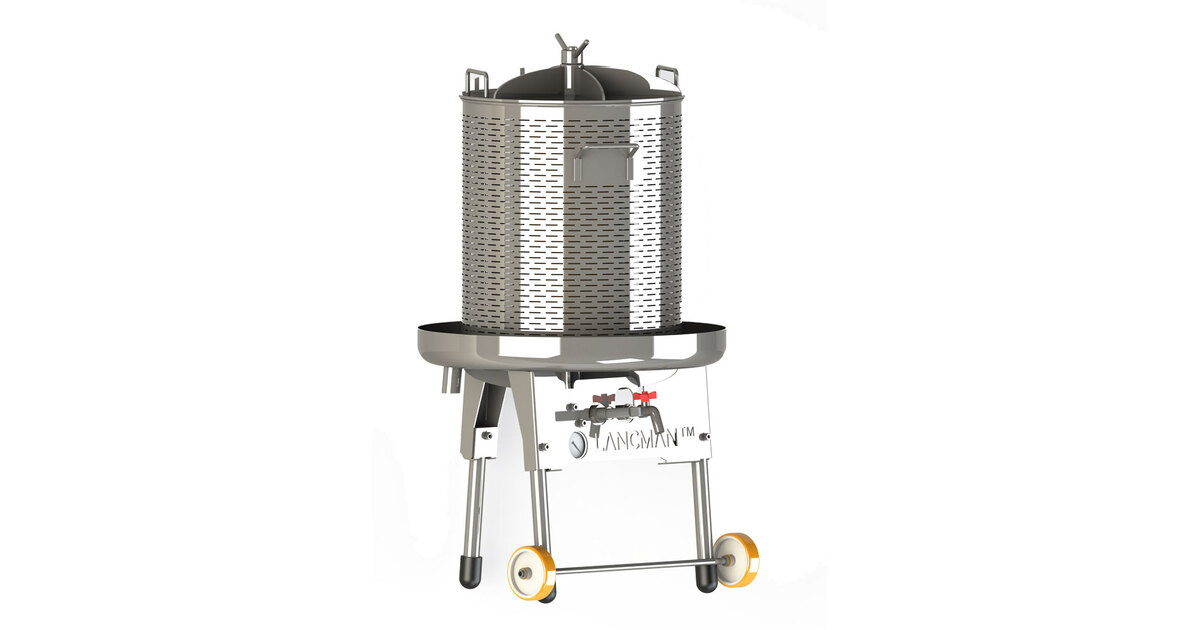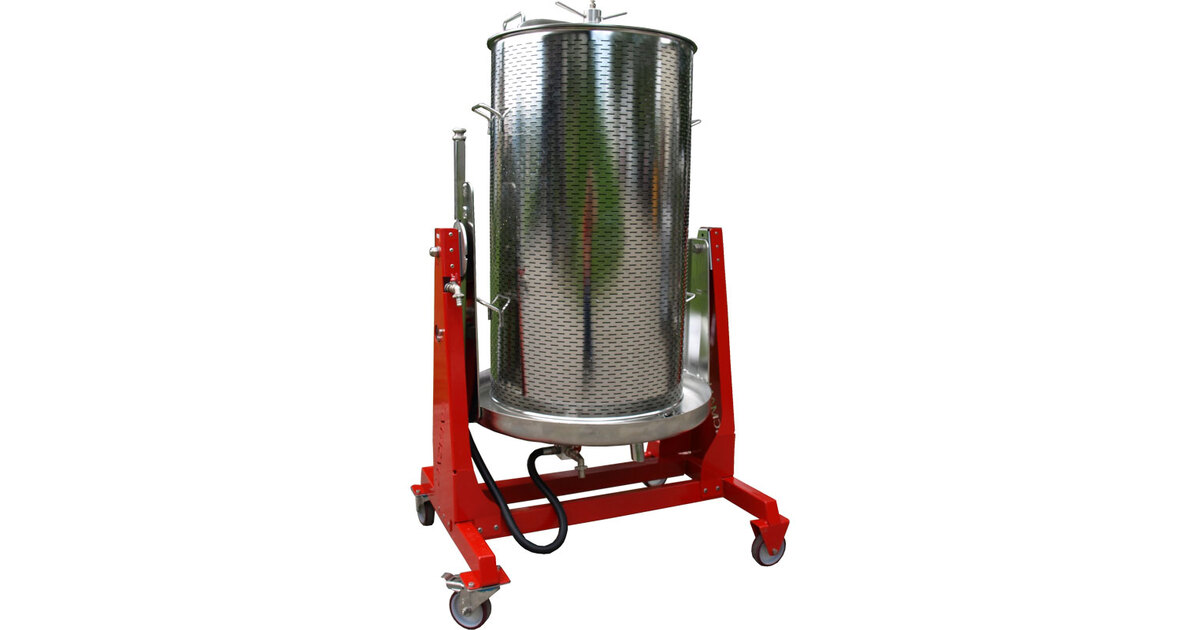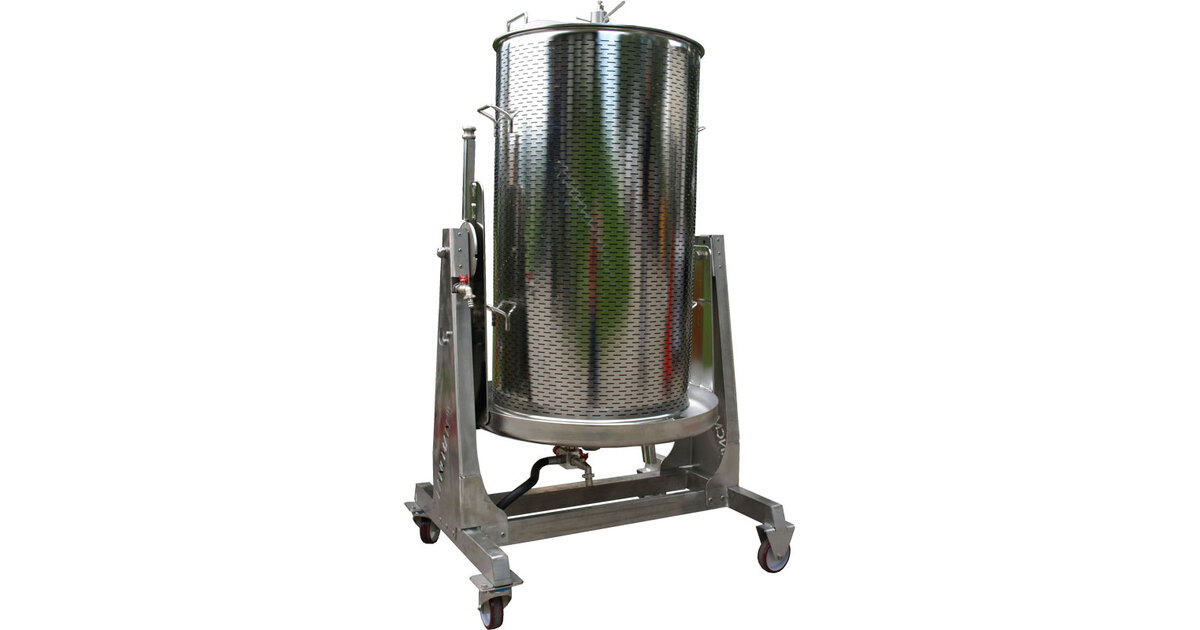Winegrowers Supplies - Hydro-presses (using water pressure) - 20 to 230 litres capacity
These are vertical presses which will produce a clearer juice (or red wine) than large horizontal presses. They are also very good for milled apples, pears and also soft fruit.
A vertical press will work well when at least a quarter full. If you have less grapes than this I would still de-stalk the bunches but put the stalks into the press on top of the grape mash, then the juice flowing out will not come in contact with the stalks.
With grapes: after the first pressing has finished it is necessary to empty out the pressed mash, crumble it and then press again; the extra volume of juice obtained from the second pressing is about 15% of that from the first pressing. A third pressing can be carried out but that gives only about an additional 2.5% juice, so it is often not worth the time involved, especially when using the smaller presses.
With milled apples: usually it is only necessary to press once, unless the pulp is very mushy and still juicy after the first pressing.
The remains of 2 or 3 first pressings can be put together to make a second pressing.
With red grape 'marc': only a single pressing is carried out. There has been a trend in recent years by progressive winemakers to press the fermented mash ('marc') of red grapes
in vertical 'basket' presses. This gives a gentle treatment as there is relatively little movement of the marc during the pressing operation; movement causes cellular breakdown and
an increase in the amount of sludge/deposit in the press wine. The draining performed by the bed of grape marc also aids the clarity of the wine.
Hydro-presses have a vertical neoprene-rubber-bladder inside a perforated stainless steel cylindrical basket. Pressure is exerted gently and evenly by the rubber bladder.
It is easier to use and easier to clean and sterilise than a traditional basket press. The pressing time is about 30 minutes, for grapes or apples.
The speed advantage of the hydro-press is due to the relatively thin layer of mash between bladder and cage wall, much less than with a traditional basket press.
Consequently the juice has much less distance to travel through. This time saving is particularly worthwhile as there is less oxidation of the juice.
Note: before filling, the press-sack is placed around the inside of the stainless steel cylinder, the bottom of the sack should be tucked inwards so that it lays underneath
the mash, to completely envelope it. If this is not done properly then mash will squeeze out below the sack.
After filling, the top of the sack is folded over the mash before the lid is put on, so that the sack encloses the mash.
As the water flows in, and the pressure exceeds 1 bar, the air-vent tip at the very top of the press must be pressed down until all air is vented and water starts to splutter out.
Note: a few people have used air instead of water to inflate the bladder, this is NOT permitted with water-powered hydro-presses.
It can be very dangerous, they are 'pressure vessels' and can expode.
I can supply a water recycling system for saving water, instead of wasting mains water; details are at the end of this webpage.
![]()
Lancman hydro-presses: with one green press sack included:-
Female hose-tail-connectors are fitted: for 13 mm (½") internal diameter hose on the inlet (water supply from a tap or recycling system; 'garden hose'
and galvanised hose-clips can be used for connection of the inlet), and 20 mm (¾") internal diameter hose on the outlet; the larger
diameter hose must be used to drain the water back to a reservoir or to a nearby drain; if you were to use 13 mm id outlet hose the water would drain very slowly.
Also, it's important to remove the small plastic filter in the exit tap, otherwise the water will flow out too slowly.




 230 litre, £89.00
230 litre, £89.00

 with 20 litre membrane-lined stainless steel pressure-tank under the pump,
with 20 litre membrane-lined stainless steel pressure-tank under the pump,